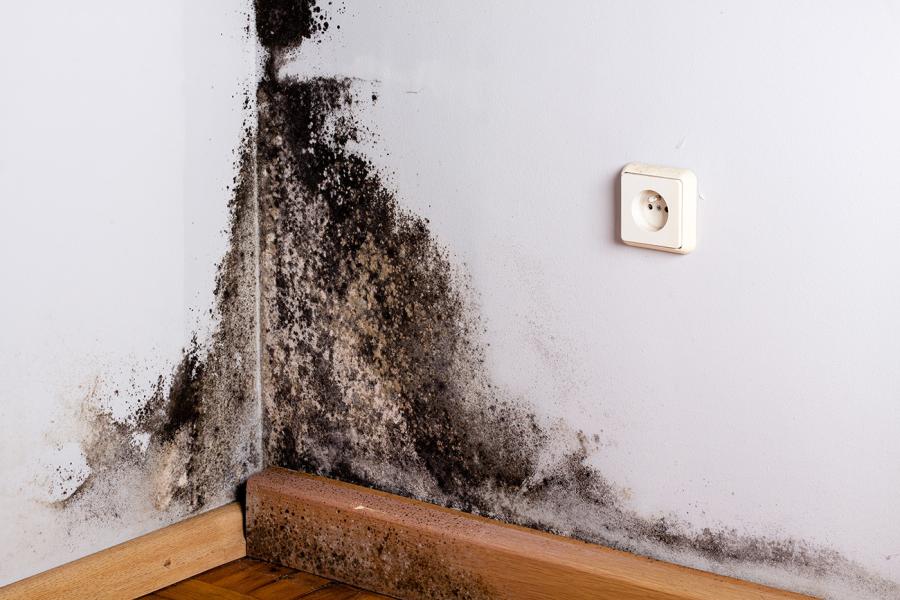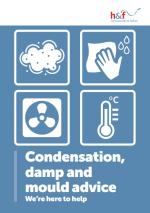What is condensation?
Air holds moisture, even when you cannot see it. When the air in your home holds too much water vapour, it will condense as moisture causing the air to feel damp.
Condensation mostly occurs where warm moist air hits cold surfaces such as around windows, cold external walls or areas with little to no air movement.
You may see small drops of water on walls or windows.

What is mould?
Mould is a type of fungus that grows and develops in damp or humid conditions and where condensation is present. Removing mould permanently is difficult and it will routinely recur mainly in Autumn and Winter. Microscopic spores are always present in the air and traditional housing means that cold walls allow them to grow, even if the heating is routinely on and the property is well ventilated throughout the year.
When the humidity levels get too high, or where moisture is present in the structure of a building, mould and mildew growth becomes likely.
Mould will often present as small black spots covering an area.
Cold air holds less moisture than warm air. This means that there is an increased chance of condensation, mould and mildew growth in the colder months of the year.
What we are doing to resolve cases of damp and mould
For council tenants
Hammersmith & Fulham Council are making a number of changes to how we manage damp and mould both strategically across the borough and at an individual property level, including:
- Investing £600 million in buildings as part of our 12 year capital strategy.
- Delivering a planned preventative maintenance programme to clear drainage stacks.
- Completing a stock condition survey (including a Housing Health and Safety Rating System Assessment which assesses risks relating to damp and mould) of all our properties over the next two years.
What will happen when you contact us about damp and mould?
- We will arrange for a surveyor to attend your property. The surveyor will assess the current situation and look at what is needed to resolve any current mould in your home and what can be done to reduce the possibility of it happening again.
- Depending on your personal circumstances, the surveyor may make a decision that you would need to temporarily move from your home to protect your health while works are carried out.
- The surveyor will in the first instance, raise works for mould treatment as it is important for the mould to be treated as soon as possible.
- Our nominated contractor will attend your property and carry out the mould treatment.
- Once the treatment has been completed, further works will be raised where appropriate to reduce the possibility of mould occurring again.
- Once works are completed, we will contact you again about six weeks after the works were done to carry out another inspection to see if the actions carried out have been successful.
- The surveyor will give you advice while at your home and may also provide you with information and/or equipment to help you manage condensation in your home.
For private rented property
Read about what the council is doing to deal with damp and mould problems in private rented property.
How can I manage condensation and mould?
There are a few simple steps that can help you reduce condensation and mould in your home.
Produce less moisture
Moisture is released into the air through everyday activities such as cooking, washing, bathing, even breathing.
You can reduce this by:
- covering pots and pans when cooking
- opening windows to allow moisture to escape
- pouring an inch of cold water in the bath before adding hot water
- washing or replacing a shower curtain regularly
- wiping down windows and sills and other surfaces where condensation forms on a regular basis
- wringing out clothes rather than drying them on the radiator
- if there is an electrical extractor fan, please use this when bathing or showering
- drying laundry outside where possible.
If you need to dry laundry indoors, put it in the bathroom with the door closed and the window open or extractor fan on.
If you have a tumble dryer, ventilate it to the outside.
Ventilate to remove moisture
Tips for ventilating your home:
- keep a small window ajar where safe to do so or putting on the window lock
- ventilate kitchens and bathrooms when in use by opening the windows or using an extractor fan
- close kitchen and bathroom doors when they are in use
- avoid putting too many things in wardrobes and cupboards which will stop air circulating
- avoid pushing furniture right up against walls so air cannot circulate around it
- don't block trickle or ventilation grilles and air bricks.
Insulate, draught proof and heat your home
In cold weather keep a low background heat on all day above 15 degrees.

Mechanically remove moisture
Electrical dehumidifiers are electrical appliances that reduce and maintain the level of humidity in the air. They are excellent for removing moisture from the air and help with drying washing. The air filter needs to be cleaned weekly and water emptied daily. They cost around 23-30p an hour to run so are not cheap, but they are effective.
Disposable desiccant dehumidifiers such as calcium chloride and silica gel can absorb moisture but cannot be used for large spaces.
Dehumidifiers can be purchased from your local home improvement stores. Follow all instructions carefully.
How can I remove mould?
Vinegar
Vinegar is a mild acid which can kill 82% of mould species - it is natural, non-toxic and doesn't give off dangerous fumes like bleach does.
Put white vinegar in a sprayer or bowl, wipe or spray on mould leave for an hour and then wipe down. This may need to be repeated regularly to reduce reappearance.
Baking Soda
Unlike other mould killers which contain harsh chemicals, baking soda is mild (pH of 8.1) and harmless to your family and any pets.
Add one quarter of a tablespoon of baking soda to a spray bottle of water. Wipe down the mouldy area with the baking soda and water solution. Scrub away the mould. This may need to be repeated. You can combine the vinegar and baking soda as an alternative.
Bleach
If the mould is growing on non-porous materials such as tiles, baths, glass and countertops you can, if used safely, wipe them down with bleach and water solution.
Clothes and carpets
Dry-clean any mildewed clothes and shampoo carpets.
Do not brush or vacuum mould. Disturbing mould by brushing or vacuum cleaning can increase the risk of respiratory problems.
How to report damp and mould problems
Private rented property tenants
If you are a tenant of a private landlord, first tell your landlord about it. If this does not solve the issue, report to phs@lbhf.gov.uk or 0208 753 1081
Housing association tenants
If you are a tenant of a housing association, first tell your landlord about it. If necessary use their complaints procedure and the Home | Housing Ombudsman. If this does not solve the issue, report to phs@lbhf.gov.uk or 0208 753 1081
Council tenants
If you are a tenant of the council contact 0800 023 4499 or housing.repairs@lbhf.gov.uk or report it online.
Condensation, damp and mould advice booklet

Downloadable condensation, damp and mould guide.
Damp and mould policy
Council housing damp and mould policy
Further resources for tenants
The following resources indicate how tenants can approach damp and mould in their rented properties.
- How to rent: guide for tenants in the private rented sector to help them understand their rights and the process of renting.
- Guide for tenants: Homes (Fitness for Human Habitation) Act 2018: guide for tenants in the social and private rented sectors on their rights under the Homes (Fitness for Human Habitation) Act.
- Damp and mould: what tenants need to know - Shelter: information for tenants on damp and mould, covering answers to common questions. This covers the health impacts and causes of damp and mould as well as how to address issues.
- Damp and mould in private rented homes - Shelter: advice and resources for private tenants who have identified damp and mould in their home, including advice on raising issues with landlords.
- Shelter provides housing advice for tenants on housing issues and legal aid and free legal advice for tenants who qualify for advice and representation to address serious housing problems.
- Damp repairs in rented housing: advice for tenants on different types of damp, who's responsible for addressing them and how, as well as routes to escalate concerns if the landlord doesn't take action.
- Dealing with damp and condensation, NEA leaflet
- Indoor air pollution (Asthma+Lung UK): resources for people living with a lung condition, including information on the types of air pollution they might have in their home and how to manage allergies caused by indoor pollution at home.
- Moisture in homes (UK Centre for Moisture in Buildings (UKCMB)): resource outlining causes of moisture build up in homes and how to manage this. This resource has been developed for homeowners. However, information on how moisture builds up and day-to-day methods for managing this may still be valuable to tenants.